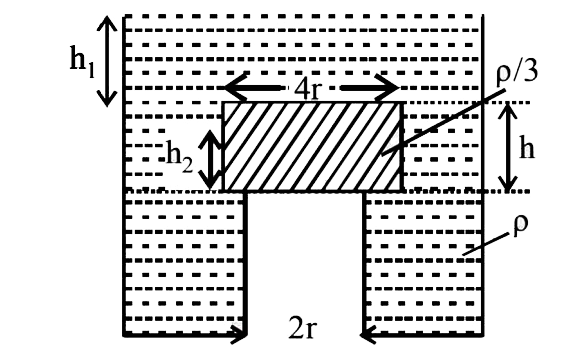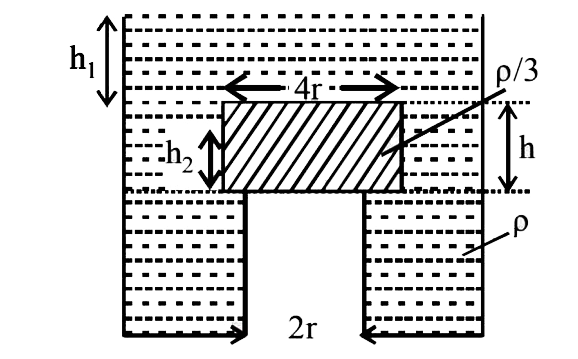A large cylindrical tank has a hole of area A at its bottom. Water is oured in the tank by a tube of equal cross sectional area A ejecting water at the speed v.
Water level in tank keeps on rising
No water can be stored in the tank.
Water level will rise to a height v2/2g and then stop.
The water level will be oscillating.
The correct Answer is:C
To solve the problem, we need to analyze the flow of water into and out of the cylindrical tank. We will derive the conditions under which the water level remains constant, rises, or falls.
1. Identify the Variables:
- Let A be the cross-sectional area of the hole at the bottom of the tank and the tube.
- Let v be the speed of water being poured into the tank.
- Let h be the height of water in the tank.
- The speed of water exiting the hole at the bottom of the tank can be determined using Torricelli's theorem, which states that the speed vout of fluid flowing out of an orifice under the influence of gravity is given by:
vout=√2gh
2. Calculate the Volumes:
- The volume of water entering the tank per unit time (inflow) is:
Vin=A⋅v
- The volume of water exiting the tank per unit time (outflow) is:
Vout=A⋅vout=A⋅√2gh
3. Establish the Condition for Steady State:
- For the water level in the tank to remain constant, the inflow must equal the outflow:
Vin=Vout
- Substituting the expressions for inflow and outflow:
A⋅v=A⋅√2gh
- We can simplify this by canceling A (assuming A≠0):
v=√2gh
4. Square Both Sides:
- Squaring both sides gives:
v2=2gh
5. Solve for Height h:
- Rearranging the equation to find h:
h=v22g
6. Analyze the Scenarios:
- If v>√2gh, then Vin>Vout and the water level will rise.
- If v<√2gh, then Vin<Vout and the water level will fall.
- If v=√2gh, then Vin=Vout and the water level will remain constant at h=v22g.
7. Conclusion:
- The water level will rise to a height of v22g and then stabilize at this height, where the inflow equals the outflow.
Final Answer:
The water level will rise to a height of v22g and then stop.
- Let A be the cross-sectional area of the hole at the bottom of the tank and the tube.
- Let v be the speed of water being poured into the tank.
- Let h be the height of water in the tank.
- The speed of water exiting the hole at the bottom of the tank can be determined using Torricelli's theorem, which states that the speed vout of fluid flowing out of an orifice under the influence of gravity is given by:
vout=√2gh
- The volume of water entering the tank per unit time (inflow) is:
Vin=A⋅v
- The volume of water exiting the tank per unit time (outflow) is:
Vout=A⋅vout=A⋅√2gh
- For the water level in the tank to remain constant, the inflow must equal the outflow:
Vin=Vout
- Substituting the expressions for inflow and outflow:
A⋅v=A⋅√2gh
- We can simplify this by canceling A (assuming A≠0):
v=√2gh
- Squaring both sides gives:
v2=2gh
- Rearranging the equation to find h:
h=v22g
- If v>√2gh, then Vin>Vout and the water level will rise.
- If v<√2gh, then Vin<Vout and the water level will fall.
- If v=√2gh, then Vin=Vout and the water level will remain constant at h=v22g.
- The water level will rise to a height of v22g and then stabilize at this height, where the inflow equals the outflow.
The water level will rise to a height of v22g and then stop.
Topper's Solved these Questions
- FLUID MECHANICSBook:CENGAGE PHYSICS ENGLISHChapter:FLUID MECHANICSExercise:Multipe Correct
Explore 15 Videos
- FLUID MECHANICSBook:CENGAGE PHYSICS ENGLISHChapter:FLUID MECHANICSExercise:Assertion-Reasoning
Explore 8 Videos
- FLUID MECHANICSBook:CENGAGE PHYSICS ENGLISHChapter:FLUID MECHANICSExercise:Subjective
Explore 25 Videos
- DIMENSIONS & MEASUREMENTBook:CENGAGE PHYSICS ENGLISHChapter:DIMENSIONS & MEASUREMENTExercise:Integer
Explore 2 Videos
- GRAVITATIONBook:CENGAGE PHYSICS ENGLISHChapter:GRAVITATIONExercise:INTEGER_TYPE
Explore 1 Video
Similar Questions
A cylindrical tank has a hole of 1cm2 in its bottom. If the water is allowed to flow into the tank from a tube above it at the rate of 70cm3/sec, then the maximum height up to which water can rise in the tank is
View SolutionA cylindrical tank has a hole of 1cm2 in its bottom. If the water is allowed to flow into the tank from a tube above it at the rate of 70cm3/sec, then the maximum height up to which water can rise in the tank is
View SolutionA tank has a hole at its bottom. The time needed to empty the tank from level h1 to h2 will be proportional to
View SolutionA cylindrical tank has a small hole at bottom. At t=0, a tap starts to supply water into the tank at a constant rate βm3/s.
(a) Find the maximum level of water Hmax in the tank ?
(b) At what time level of water becomes h(h<Hmax) Given a , area of hole, A : area of tank.
View SolutionA cylindrical tank has a hole of diameter 2r in its bottom. The hole is covered wooden cylindrical block of diameter 4r, height h and density ρ/3.

Situation I: Initially, the tank is filled with water of density ρ to a height such that the height of water above the top of the block is h1 (measured from the top of the block).
Situation II: The water is removed from the tank to a height h2 (measured from the bottom of the block), as shown in the figure. The height h2 is smaller than h (height of the block) and thus the block is exposed to the atmosphere.
In situation 2, if h2 is further decreased, then
View SolutionA cylindrical tank has a hole of diameter 2r in its bottom. The hole is covered wooden cylindrical block of diameter 4r, height h and density ρ/3.

Situation I: Initially, the tank is filled with water of density ρ to a height such that the height of water above the top of the block is h1 (measured from the top of the block).
Situation II: The water is removed from the tank to a height h2 (measured from the bottom of the block), as shown in the figure. The height h2 is smaller than h (height of the block) and thus the block is exposed to the atmosphere.
Find the minimum value of height h1 (in situation 1), for which the block just starts to move up?
View SolutionA cylindrical tank has a hole of diameter 2r in its bottom. The hole is covered wooden cylindrical block of diameter 4r, height h and density ρ/3.

Situation I: Initially, the tank is filled with water of density ρ to a height such that the height of water above the top of the block is h1 (measured from the top of the block).
Situation II: The water is removed from the tank to a height h2 (measured from the bottom of the block), as shown in the figure. The height h2 is smaller than h (height of the block) and thus the block is exposed to the atmosphere.
Find the minimum value of height h1 (in situation 1), for which the block just starts to move up?
View SolutionT=R2r2√2hg
Suppose an open cylindrical tank has a round drain with radius t in the bottom of the tank. When the tank is filled with water to a depth of h centimeters, the time it takes for all the water to drain from the tank is given by the formula above, where R is the radius of the tank (in centimeters) and g=980cm/s2 is the acceleration due to gravity. Suppose such a tank has a radius of 2 meters and is filled to a depth of 4 meters. About how many minutes does it take to empty the tank if the drain has a radius of 5 centimeters? (1 meter=100 centimeter).
View SolutionA cylindrical tank of height H is open at the top end and it has a radius r. Water is filled in it up to a height of h. The time taken to empty the tank through a hole of radius r' in its bottom is
View SolutionWater rises to a height h in a capillary tube of cross-sectional area A. the height to which water will rise in a capillary tube of cross-sectional area 4A will be
View Solution
